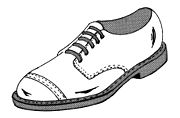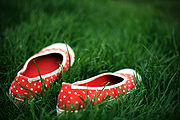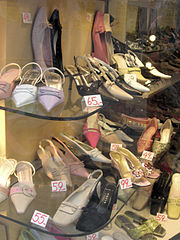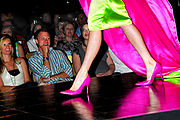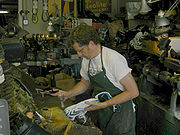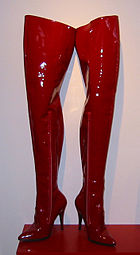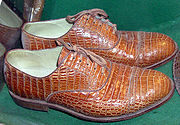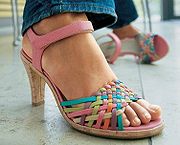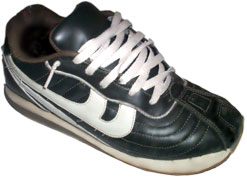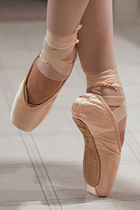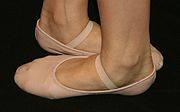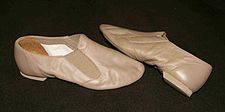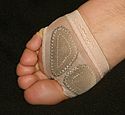
Shoe
Background to the schools Wikipedia
This selection is made for schools by a children's charity read more. Visit the SOS Children website at http://www.soschildren.org/
A shoe is an item of footwear. Shoes may vary from a simple flip-flop to a complex boot. Shoes may have high or low heels, although in western cultures, high heels are considered a women's style. Shoe materials include leather or canvas. Athletic shoe soles may sometimes be made of rubber.
History
The earliest known shoes date from about 8000 to 7000 BCE and were found in Oregon, USA in 1938. However, the materials used for making shoes do not normally last for thousands of years, so shoes were probably in use long before this. Physical anthropologist Erik Trinkaus believes he has found evidence that the use of shoes began in the period between about 40,000 and 26,000 years ago, based on the fact that the thickness of the bones of the toes (other than the big toe) decreased during this period, on the premise that going barefoot results in greater bone growth before this period.
Parts of a shoe
Sole
The bottom of a shoe is called the sole.
Insole
The insole is the interior bottom of a shoe, which sits directly beneath the foot. Many shoes have removable and replaceable insoles, and extra insoles are often added for comfort or health reasons (to control the shape, moisture, or smell of the shoe).
Outsole
The outsole is the layer in direct contact with the ground. Dress shoes have leather outsoles; casual or work-oriented shoes have outsoles made of natural rubber or a synthetic imitation. The outsole may comprise a single piece, or may comprise separate pieces of different materials. Often the heel of the sole is rubber for durability and traction, while the front is leather for style. Specialized shoes will often have modifications on this design: athletic cleats have spikes embedded in the outsole to grip the ground; many kinds of dancing shoes have much softer or harder soles.
Midsole
The layer in between the outsole and the insole that is typically there for shock absorption. Some types of shoes, like running shoes, have another material for shock absorption, usually beneath the heel where one puts the most pressure down. Different companies use different materials for the midsoles of their shoes. Some shoes may not have a midsole at all.
Heel
The bottom rear part of a shoe is the heel. Its function is to support the heel of the foot. They are often made of the same material as the sole of the shoe. This part can be high for fashion or to make the person look taller, or flat for a more practical use.
Vamp, or upper
Any shoe has an upper part that helps hold the shoe onto the foot. In the simplest cases, such as sandals or flip flops, this may be nothing more than a few straps for holding the sole in place. Closed footwear, such as boots, sneakers and most men's shoes, will have a more complex upper. This part is often decorated or is made in a certain style to look attractive. The U.S. Patent 3,355,535, from 1967, describes a method for producing a shoe-upper (Hain 1967).
Accessories to shoes
- Shoehorn: can be used to insert a foot into a shoe by keeping the shoe open and providing a smooth surface for the foot to slide upon.
- Shoe tree: placed inside the shoe when user is not wearing it, to help maintain the shoe's shape.
- Shoe polishing equipment:
-
- Shoe polish: a waxy material spread on shoes to improve appearance, glossiness, and provide protection.
- Shoe brush and polishing cloth: used to apply polish to shoes.
- Overshoes or galoshes: a rubber covering placed over shoes for rain and snow protection.
- (Orthopedic) shoe insert: insert of various materials for cushioning, improved fit, or reduced abrasion. These include padding and inner linings. Inserts may also be used to correct foot problems.
- Shoe bag: a bag that protects shoes against damage when they are not being worn.
- Shoe stretcher: a tool for making a shoe longer or wider or for reducing discomfort in areas of a shoe.
- Snow shoe: a wooden or leather piece which increases the area of ground covered by the shoe.
- Shoelaces: a system used to secure shoes.
Types of shoes
Dress and casual shoes
Dress shoes are categorized by smooth and supple leather uppers, leather soles, and narrow sleek figure. Casual shoes are characterized by sturdy leather uppers, non-leather outsoles, and wide profile.
Some designs of dress shoes can be worn by either gender. The majority of dress shoes have an upper covering, commonly made of leather, enclosing most of the lower foot, but not covering the ankles. This upper part of the shoe is often made without apertures or openings, but may also be made with openings or even itself consist of a series of straps, e.g. an open toe featured in women's shoes. Shoes with uppers made high to cover the ankles are also available; a shoe with the upper rising above the ankle is usually considered a boot but certain styles may be referred to as high-topped shoes or high-tops. Usually, a high-topped shoe is secured by laces or zippers, although some styles have elastic inserts to ease slipping the shoe on.
Men's shoes
Men's shoes can be categorized by how they are closed:
- Balmorals: the vamp has a V-shaped slit to which the laces are attached; also known as "closed lacing". In England, the balmoral is known as the Oxford. The word "Oxford" is used by American clothing companies to market shoes that are not balmorals, such as rubber-sole bluchers.
- Blüchers: the laces are tied to two pieces of leather independently attached to the vamp; also known as "open lacing". In England, the Blucher is known as the Derby shoe.
- Monk-straps: a buckle and strap instead of lacing
Various other closings exist but are less popular such as side-elastic closings.
Men's shoes can also be decorated in various ways:
- Plain-toes: have a sleek appearance and no extra decorations on the vamp.
- Cap-toes: has an extra layer of leather that "caps" the toe. This is possibly the most popular decoration.
- Brogues (American: wing-tips): The toe of the shoe is covered with a perforated panel, the wing-tip, which extends down either side of the shoe. Brogues can be found in both balmoral and blucher styles.
Women's shoes
There is a large variety of shoes available for women, in addition to most of the men's styles being more accepted as unisex. Some broad categories are:
Pumps, known in the US and UK as ballerinas, ballet pumps or skimmers, are shoes with a very low heel and a relatively short vamp, exposing much of the instep. They are popular for warm-weather wear, and may be seen as more comfortable than shoes with a higher heel.
High heels may be shoes with heels 2 inches (5 cm) or higher. They are often seen as having more sex appeal than low heels (see article for discussion) and are thus commonly worn by women for formal occasions or social outings.
- Sneaker boot and sneaker pump: a shoe that looks like an athletic shoe, but is equipped with a heel, making it a kind of novelty dress shoe.
Either gender
- Clog
- Platform shoe: shoe with very thick soles and heels
- Moccasin: originated by Native Americans, a soft shoe without a heel and usually made of leather.
- Sandals: open shoes consisting of a sole and various straps, leaving much of the foot exposed to air. They are thus popular for warm-weather wear, because they let the foot be cooler than a closed-toed shoe would.
- Saddle shoe: leather shoe with a contrasting saddle-shaped band over the instep, typically white uppers with black "saddle".
- Loafer: a dress or casual shoe without laces; often with tassels, buckles, or coin-holders (penny loafers).
- Boating shoes, also known as boat shoes and deck shoes: similar to a loafer, but more casual. Laces, if present, are usually simple leather (often two-tone) with no frills. Often made of canvas or featuring a white sole. They have soft soles/heels to avoid marring or scratching a boat deck.
- Boots: Long shoes (covering the ankle) frequently made of leather. Some are designed to be used in times of bad weather, or simply as an alternate style of casual or dress wear. Styles include rubber boots and snow boots, as well as work boots and hiking boots.
- Slippers: For indoor use, commonly worn with pajamas.
Athletic shoes
Men's and women's athletic shoes and special function shoes often have less difference between the sexes than in dress shoes. In many cases these shoes can be worn by either sex. Emphasis tends to be more on function than style.
- Sneakers/trainers (also called gym shoes or tennis shoes): general purpose athletic shoes; made out of rubber, cloth, and/or plastic to be lightweight, flexible, and have good traction. Special varieties are available for basketball or tennis.
- Running shoes: very similar to above, with additional emphasis on cushioning.
- Track shoes: lightweight; often with plastic or metal cleats
- Cleat (shoe): a type of shoe featuring molded or removable studs. Usually worn while playing sports such as rugby, football, American football, or baseball.
- Golf shoes: with "spikes" for better grip in grass and wet ground. Originally the spikes or "cleats" were made of metal but replaceable "soft spikes" made of synthetic plastic-like materials with prongs distributed radially around the edge of each spike are much more common today (and are required on many golf courses since they cause less damage to the greens).
- Bowling shoes: intermediate style between ordinary dress shoes and athletic shoes. They have harder rubber soles/heels so as not to damage bowling alley floors. They are often rented or loaned at bowling alleys.
- Climbing shoes: a shoe designed for rock climbing. They typically have a close fit, little if any padding, and a smooth sticky rubber sole with an extended rubber rand.
- Hiking shoes or boots: usually have a high somewhat stiff upper with many lace eyelets, to provide ankle support on uneven terrain, with extra large traction on the sole.
- Walking shoes: have a more flexible sole than the running shoe, lighter in weight than the hiking boot, may have air holes, may not be water proof.
- Skating shoes: typically called skates. They have various attachments for skating on the bottom of the shoe portion.
- Ice skates
- Roller skates
- Inline skates
- Ski boot: a large, thick plastic boot specially designed for attachment to the ski.
- Skateboarding shoes have flat soles for a better grip on a skateboard. They are very wide and have extra layers of padding to protect the skateboarders feet.
- Cycling shoes are equipped with a metal or plastic cleat to interface with clipless pedals, as well as a stiff sole to maximize power transfer and support the foot.
- Snowshoes are special shoes for walking in thick snow. In temperate climates, snowshoes are used for mostly recreational purposes in winter.
- Wrestling shoes are light, flexible shoes that mimic bare feet while providing additional traction and protection.
Orthopedic shoes
Orthopedic or "comfort" shoes are made with pedorthic and anatomically-correct comfort qualities, such as padded removable footbeds, wide toe boxes and arch support are made especially for those with problematic feet.
Dance shoes
- Pointe shoes. Designed for ballet dancing. These have a toe box that is stiffened with glue and a hardened sole so the dancer can stand on the tips of their toes. They are secured by elastic straps and ribbons that are tied to the dancer's ankles.
- Ballet shoes Heel-less slippers made of canvas or leather, with either continuous or two-part sole (i.e., split-sole). The sole is typically made of leather, with thicker material under the ball and heel of the foot, and thinner and thus more flexible material under the arch so that the foot can be pointed to its utmost. Ballet slippers are usually secured by elastics that cross over the top of the foot. They are most commonly pink, white, black, or pale tan, although they may be made in specialty colours such as red or blue.
- Jazz shoes. These typically have a two-part, rubberized sole (i.e., split-sole) to provide both flexibility and traction, and a low (one inch or shorter) heel. They are secured to the foot by laces or elastic inserts.
- Tango/flamenco dance shoes.
- Ballroom shoes. They fall into two categories for the two genres of dances as defined by the IDSF (International DanceSport Federation): Ballroom and Latin American. Both are characterised by suede soles. Mens' Ballroom shoes are typically lace-ups with 1-inch heels and patent leather uppers. Ladies' Ballroom shoes are typically court shoes with low 2-inch heels, usually made of fabric so that they can be finished with a greater variety of colours to match the dancer's dress. The low Ballroom heel distributes the dancer's weight across the foot while Latin American shoes have higher heels designed to throw the dancer's weight on to the toes and the soles are more flexible. Men's Latin shoes typically have 1.5-inch to 2-inch shaped heels while Ladies' Latin shoes have 2,5-inch to 3-inch heels, open-toed and strapped.
- Dance sneakers. Also known as dansneakers, these are a combination of a sneaker and a dance shoe, with a reinforced rubber toe.
- Character shoes. Shoes with a one to three inch heel, which are usually made of leather, and often have one or more straps across the instep to secure the foot during dance. They may come in soft-soled (suede) or hard-soled varieties. They may be converted to tap shoes by attaching taps.
- Foot thongs. Variously called called Foot Paws and FootUndeez, depending on the manufacturer, these are slip-on, partial foot covers that protect the ball of a dancer's foot from skin abrasions while executing turns. From a distance, flesh colored foot thongs give a dancer the appearance of having bare feet.
Work shoes
Work shoes are designed to stand heavy wear, to protect the wearer, and provide high traction. They are generally made from sturdy leather uppers and non-leather outsoles. Sometimes they are used for uniforms or comfort by nurses, waitresses, police, military personnel, etc. They are commonly used for protection in industrial settings, construction, mining, and other workplaces. Protective features may include steel-tipped toes and soles or ankle guards.
Shoe etiquette
In most parts of the world (Asia, Eastern Europe, parts of the Middle East and Africa, much of Northern Europe and Canada, as well as Alaska) it is customary to remove shoes when entering a house. In some areas of the United States, especially the Midwest, it is expected that visitors remove their shoes unless a host specifically invites them to leave their shoes on. People do this to avoid bringing dirt, mud or snow into the house. For some societies, including those in Asia, indoor footwear may be provided for guests.
In the Middle East, parts of Africa, Korea and Thailand, it is considered rude to show the soles of the feet to others (even accidentally, such as by crossing the legs). In addition, in Thailand, it is an extreme insult for the foot, socks, or shoes to touch someone's head or be placed over it. Although feet touching heads is an extremely rare occurrence in any society, some Muay Thai boxers insult each other by "kicking" the opponent's head with their foot (most Muay Thai kicks are executed with the shin).
See also dress code.
